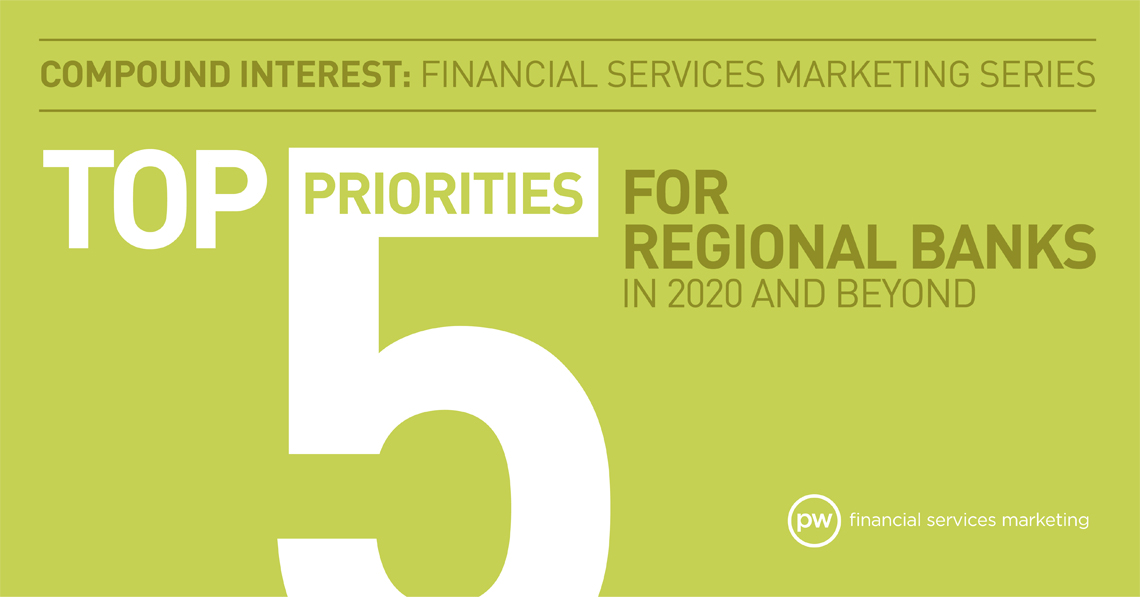If you’re like me, the beginning of the new year means you’ve spent some time thinking through the opportunities and risks that lie ahead in 2020, hopeful that with the right marketing plan, you can enable your institution to grow, keeping customers, employees and the board content. But often, input from stakeholders, overambitious business plans or constraints on staffing and budget mean that not every facet of your plan can be realized. In this first installment of our “Compound Interest” financial services marketing series, I’ll share some of the valuable things I’ve learned over my 30 years in bank marketing about how to put a successful plan into motion.
Before we get into my top five priorities, it’s critical to acknowledge that there will be too many issues to address fully, so defining the critical priorities based on your firm’s strategic plan is job 1. What you choose not to do and saying “no” (and how you say no) to internal constituents is as important as what you do.
1. Master the Data
Data Inventory
One challenge smaller banks face is their ability to aggregate, harness and properly use data to develop the insights needed to successfully execute a smart plan. It’s generally not that we don’t have enough data, but often that we don’t or can’t use it effectively. So the first thing on the list is to identify the data sources to which you have access (core systems, MCIF, application data, web traffic, marketing campaign analytics, customer satisfaction surveys, employee satisfaction surveys, etc.) and then to allocate resources for the analysis of that data. The goal is to machine these raw materials into the necessary insights needed to focus your efforts profitably, driven by the organizational priorities that you defined before you began.
Bigger Isn’t Better
It’s easy to believe that the “big guys” are winning because they have more money and more toys, but solid growth and valuable business intelligence is founded on the insights that you craft based on your data and your hard-earned knowledge of the communities you serve. Each branch in your markets survives and thrives in some way on its own merit. This means that there’s no reason for the “bigs” to have a material advantage over your community branches, provided you are using the resources and data you have available effectively. Anecdotal, grassroots intelligence is just as valuable as statistically valid, quantitative information when leveraged strategically.
Objectivity Rules
One thing essential to a strong, actionable output in this process is absolute objectivity. To win, enter the process of insight development assuming there are things to learn and changes to make. If you are leading marketing in an organization whose culture struggles with objectivity (e.g., a “we’ve always done it this way” mentality), consider outsourcing insight development to an objective third party. Your job as a marketer is to “tell it like it is,” even if the truth may be unpopular (backing it up with data “helps the medicine go down.”)
Affordability
When having this discussion with banks, we’re often met first with the challenge of resources to conduct insight development. Sounds both important and expensive, right? Truthfully, it does not have to be. We’ve helped even small local banks farm their available data for key insights without, well, breaking the bank. The alternative is often spending bank resources without much more than intuition as a guide. That CAN be costly, and of course, nothing is more expensive than failure without learning.
2. Brand and Value Proposition
Another way that bigger isn’t always better is in the value proposition your bank brings to customers. Reputation and brand are where regional and community banks can beat the “other” players, so it’s important to know whether your brand is vulnerable.
While much of this article discusses actionable business practices that will help you grow, brand health and reputation in an industry that requires a high degree of trust cannot be ignored. We’re talking about reputation, and that can be reflected in everything from your employees to positive or negative PR, social media listening and whether you are technologically behind or your products have not kept pace.
How people “feel” about your brand is going to be reflected in data from customer (and non-customer) research but often requires some reading between the lines. It’s common for customers to respond to product or service issues in a customer satisfaction survey (CSAT), but how do they feel? Do they trust you? Do they think of you as a caring and important part of the community while they think of the big banks as faceless juggernauts who just care about profit? If you are not regularly in touch with the ebb and flow of customer sentiment, you may be sacrificing what’s special and defensible about your brand, and it’s time to schedule regular customer check-ins. Biannual CSATs are also excellent ways to measure the more intangible effects of your marketing efforts and should be a permanent practice.
Similarly, it’s critical to measure the “state of your brand” beyond your existing customers. A periodic brand audit (annual, ideally) will reveal the efficacy of marketing investments on creating awareness, consideration and preference across lines of business as well as reveal what aspects of your brand are most attractive compared to competitors. Regardless of the frequency, not measuring brand performance will result in the gradual erosion of equity and the ability to attract customers based on value, not price.
3. Customer Experience
One thing I’ve learned is that the discipline involved in the insight process, at least annually, gives banks clarity on where to focus efforts and invest resources profitably, even if the changes made are initially nominal. Nowhere is this more apparent than in how insight development impacts customer experience.
Driving new depositor growth while retaining existing customers is tricky. Afterall your longest tenured clients have stayed with you for a reason, right? But fine-tuning and improving CX is key to both acquisition and retention. Given competitive dynamics and the potential economic roller coaster, balancing new customer acquisition, retention and cross-sell is critical. Three areas of customer experience that your insight development should impact include:
CX Segmentation
One of the first important tasks after you’ve parsed your data into actionable insights is to build a customer experience segmentation model. If you don’t have a segmentation plan already, build one. Customers increasingly demand experiences that are customized to their specific needs. The life stages and corresponding needs and expectations of Gen X, Millennial, Gen Y and Boomer customers can be very different. Likewise, established business customers will behave and expect differently than those who are just getting started. If you find, for example, that you are treating retired customers the same as young families, you have a gap in your CX that will lead to lost new accounts and higher attrition rates. The good news is that when done correctly, your data dive should identify these groups and deliver insights that lead to direct action that supports each customer journey.
Digital CX
You have online banking, of course. It’s essential to your survival, but is it helping you as much as it could be? Leverage your customer insights to request improvements from your online banking provider (or IT team) to create a smoother online experience that serves the needs of all of your customers. It’s worth repeating ALL customers because there’s a persevering myth out there that older customers won’t use online banking. While it’s true that seniors underperform in use of online features, recent studies show that banks may be causing this themselves.
Online banking that is not built with less tech-savvy customers (including seniors) in mind will deter them from participating. This leaves you with one less touch point and service portal for some of your longest standing clients. When auditing customer input on your digital CX, consider all customers, including the ones who are not using online banking, and determine whether improved accessibility for the visually impaired, simpler navigation, online chat, fraud alerts and call center support might be approachable improvements to better serve your customers. Regardless of what upgrades your customers need in digital CX, it is increasingly important to provide easy paths between digital and human experiences. While digital may continue to be a go-to for customers, integrating access to friendly, professional service staff when digital self-service is insufficient remains a must.
Prospect Experience
As a link between CX and the next priority, Product, create an intentional experience for prospective customers by channel for each product you intend to market. Product Experience (PX) is different online than in branch but as mentioned before, banks need to make the transition between channels smooth for customers.
4.Product and Pricing Strategies
Once you’ve established brand health and customer experience requirements, the next step will be to dovetail product requirements into the mix. Here you’ll define whether you have differentiated pricing and product models from the competition for different channels and customer segments. Like any business, customers will need a “reason to buy,” and you need to operate in a way that best supports your business.
For this, you or your agency resource will need to conduct an evaluation of your product lineup versus your key competitors on and off-line in order to ensure:
a) You’re competitive in terms of features, benefits and functionality
b) Your offerings are designed to fit the channel, e.g., does your “e-checking” account offer the features necessary to attract online clients (free ATM access, a mobile app to access e-statements) vs. brick and mortar (paper statements, safe deposit access, etc.)? Similarly, for pricing, are you competitive in terms of fees based on channel, and is your pricing for loans and IBD (interest bearing deposits) competitive enough to attract your target audience?
In making these decisions, you’ll need to consider your big picture objectives. If your priority is to grow your customer base, offering interim pricing incentives is imperative, while if your focus is more heavily on customer retention, this may not be as critical. Regardless of your goals, you’ll find pricing and product design to be more segmented than they used to be because audience expectations have changed to be attuned to tailored features, functionality and pricing.
5. Lines of Business
After evaluating all of the preceding factors, the next critical step is to evaluate which lines of business require and warrant investment. Traditionally, marketing resources are allocated across lines of business based on the prior year’s “plus or minus” budget growth. This can be counterproductive. Instead, data analysis and customer intelligence should drive which lines of business and which markets offer the greatest potential for growth. Different markets may see consumer growth as the greatest potential for return, while others small business, wealth or commercial. The business intelligence analysis should dictate allocations, not inertia.
By prioritizing insight-driven investment opportunities and applying the discipline needed to maximize those investments, banks are finding healthier bottom lines while improving their position in the market versus larger competitors. Regardless of where you allocate your resources, remembering that they are ultimately investments and should be deployed where they will provide the highest returns is the top mandate for the marketing team.
Over the coming year, the PW Financial Services Marketing team is looking forward to sending you practical, utilitarian insights that will help drive your bank’s performance. Our goal is to provide quality content that you can apply to your daily marketing activities and long-term marketing and product strategies. If you’d like to suggest a topic, please drop us a note here.
If you have questions about this content or need assistance in performing a marketing audit on your bank, please consider contacting us here or calling 502-499-4209.


